The Daily Routine
Male and female butterflies of any given species usually behave very differently. In most species the males are highly active, and their behaviour follows a predictable cycle of feeding, basking, and patrolling in search of females. Males of other species are often highly territorial, and will defend their territories against other insects including wasps, flies, and flying beetles. If another male of the same species enters their territory, they engage in an aerial sortie, spiralling high above the trees until the intruding butterfly is ousted.
Female butterflies live entirely different lives. Prior to mating they are often sedentary, remaining very close to the spot where they emerged from the pupa. After mating they seek places to lay their eggs, but usually fly only short distances between bouts of egg laying.
These differences in behaviour are reflected in their appearance – males need to be noticed, so are generally more colourful than females. The Adonis Blue Lysandra bellargus is a good example : the males are a brilliant iridescent blue colour, but the females are drab dark brown creatures – they spend most of their time crawling about on the ground amongst short grasses, looking for places to lay their eggs, but need to bask periodically so they can maintain their body temperatures. When basking on the ground, their drab colouration helps to camouflage them so they escape predation.
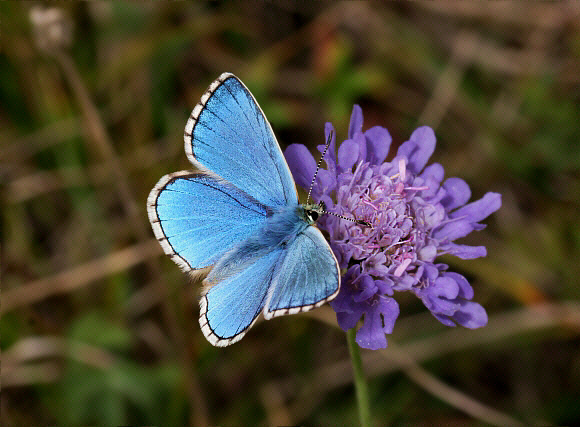
Adonis Blue Lysandra bellargus, male, Ballard Down, Dorset – Adrian Hoskins
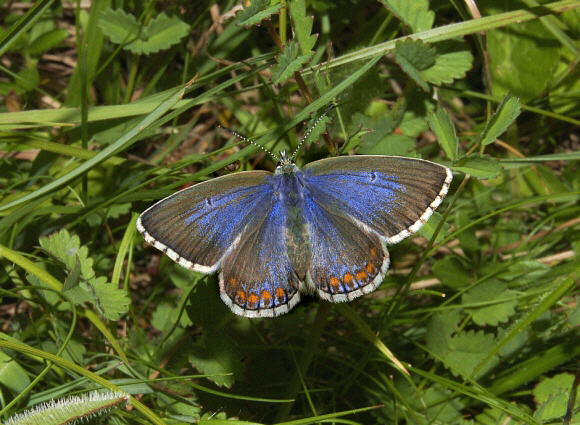
Adonis Blue Lysandra bellargus, female, Ballard Down, Dorset – Adrian Hoskins
Roosting Behaviour
In cool or rainy weather butterflies are inactive, and thus particularly vulnerable to attack by birds and small mammals.
In tropical areas many species hide away beneath leaves, even when sunny, and only come into the open to undertake specific tasks such as feeding or reproducing. This behaviour is very widespread amongst the metalmarks ( Riodinidae ) and Spreadwing skippers ( Pyrginae ).
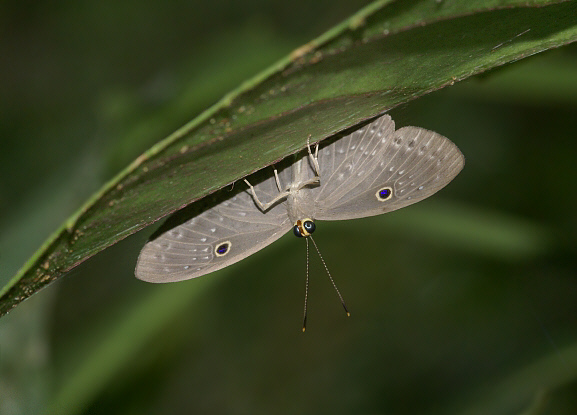
Eurybia molochina, ( Riodinidae ) hiding beneath a leaf in the Peruvian rainforest – Adrian Hoskins
In temperate zones, during periods of inclement weather, members of the Papilionidae and Pieridae normally roost beneath the leaves of herbaceous plants.
Pyrgines such as the Grizzled Skipper Pyrgus malvae usually roost at the top of dead flower-heads. The Dingy Skipper Erynnis tages behaves similarly, but takes things a stage further by wrapping it’s wings tightly around dead knapweed flowers, where it is almost impossible to see ( unless you are a very determined entomologist ! ).
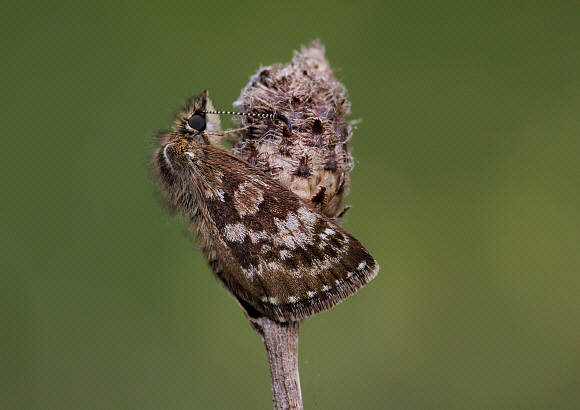
Erynnis tages, ( Pyrginae ) roosting on a dead knapweed flower, Hampshire – Adrian Hoskins
Polyommatine Blues and Satyrines such as Small Heath, Marbled White and Meadow Brown tend to roost in a head-downwards posture at the top of grass heads. Pearl-bordered Fritillaries Clossiana euphrosyne and other Melitaeines adopt a similar tactic, often roosting on bracken fronds or on the flowers of rushes.
Such strategies may at first seem a little difficult to understand, as the butterflies are easily spotted. The probable explanation is that they are selecting sites where they are out of reach of nocturnal predators such as voles or shrews.
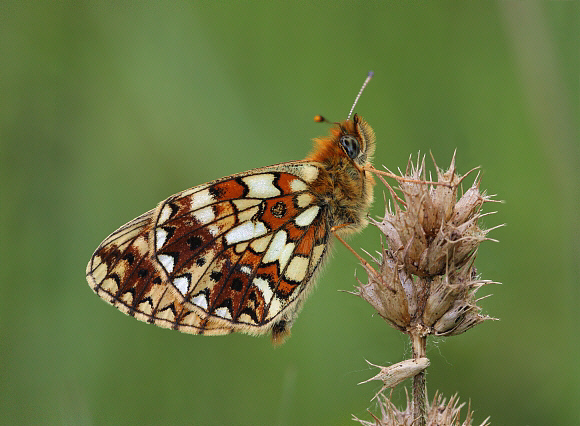
Clossiana selene, ( Nymphalinae : Melitaeini ) seed-head, Wiltshire, Kent – Adrian Hoskins
Hibernation
Hibernation is a process that depresses metabolism and energy consumption during the cold winter months. It ensures that energy is not wasted on fruitless searches for nectar and foliage in winter, and synchronises the spring reawakening with the time when flowers and fresh foliage reappear.
In temperate regions of the world most butterfly species overwinter as larvae. Others hibernate as eggs or pupae. A small number, including Inachis io, Polygonia c-album and Gonepteryx rhamni overwinter instead as adult butterflies. To successfully overwinter they need to find a place to hide where they are protected from the worst of the wind, rain and snow.
They may be in diapause for several months, and throughout this period they must remain undetected by birds. Accordingly they have evolved cryptic colours, patterns and unusual wing shapes that combine to provide them with effective camouflage.
The Brimstone Gonepteryx rhamni for example hibernates under bramble or ivy leaves and has wings coloured to match winter foliage. Its wings are also leaf-like in shape and have raised venation to simulate the veins of real leaves.
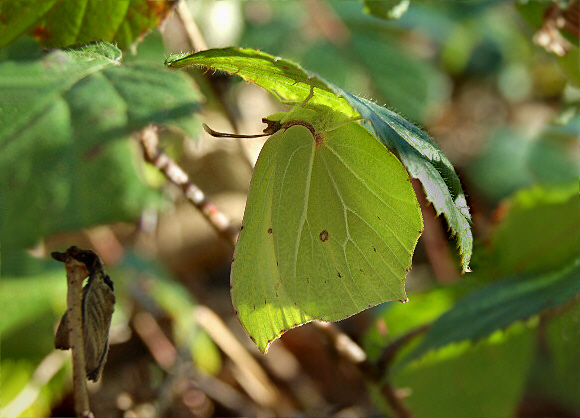
Gonepteryx rhamni, ( Pieridae ) hibernating beneath a bramble leaf, West Sussex – Adrian Hoskins
Many overwintering species such as the Peacock Inachis io, Camberwell Beauty Nymphalis antiopa and Large Tortoiseshell Nymphalis polychloros hibernate beneath logs or in hollow tree trunks; or in other dark places such as caves or animal burrows.
These species have evolved very dark ventral wing patterns which make it difficult for foraging birds to locate them in their gloomy surroundings.
A few species such as the Comma Polygonia c-album hibernate openly, hanging from tree branches or amongst piles of leaf litter on the forest floor. Their dark marbled patterns and strange angular wing shape provides them with an extremely effective dead-leaf disguise.
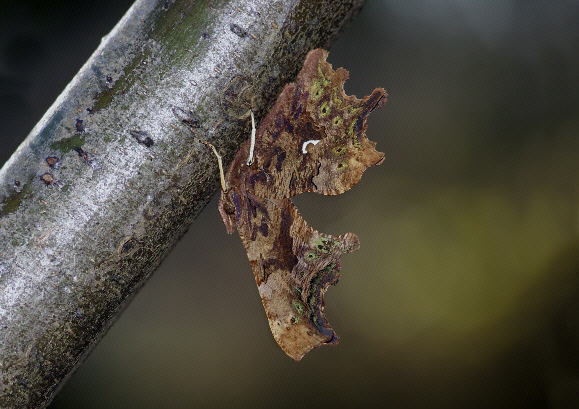
Polygonia c-album, ( Nymphalidae ) hibernating beneath a branch, West Sussex – Adrian Hoskins
Lifespan
The whole lifecycle from egg to adult can take just 3 weeks to complete in many tropical species. In temperate regions the lifecycle of the summer generation may be complete within 6 weeks, but many species only produce a single generation in a year. In sub-arctic zones some species such as Parnassius eversmanni, Boloria natazhati and Oeneis alpina take 2 years to complete the lifecycle.
The lifespan of butterflies varies considerably from one species to another. Captive butterflies, if fed regularly can live for several weeks. Wild butterflies are subject to predation and the extremes of climate, so while some may have the potential to live longer, in practice the average lifespan is just 7 or 8 days.
There are however several notable exceptions to this general rule. Some butterflies, e.g. Monarchs, Commas and Tortoiseshells, hibernate as adults, and these species often live for several months. The longest lived European species are the Brimstone and Peacock – both emerge in early July, and often survive until the following June.
Certain tropical species are also capable of surviving for equally long periods. In Central & South America female Heliconius butterflies sequester pollen from Psiguria, Anguria and Gurania flowers in the rainforest. The pollen collected from the flowers is processed by the females to extract amino acids which increase longevity and enable them to produce eggs for up to 9 months.
Other tropical species e.g. the Satyrine Taygetis mermeria and certain Ithomiines, Heliconiines and Danaines are able to extend their lives by aestivating during the dry season, and can live for up to 11 months.
